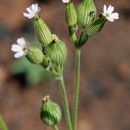Distribution in Egypt
(
Inglês
)
fornecido por Bibliotheca Alexandrina LifeDesk
Mediterranean region (Ras El-Hekma).
- autor
- BA Cultnat
- fornecedor
- Bibliotheca Alexandrina
Global Distribution
(
Inglês
)
fornecido por Bibliotheca Alexandrina LifeDesk
Portugal, Spain, Italy, Turkey, Syria, Palestine, Egypt, Iraq, Afghanistan.
- autor
- BA Cultnat
- fornecedor
- Bibliotheca Alexandrina
Comments
(
Inglês
)
fornecido por eFloras
Silene coniflora apparently was introduced into North America in the early days of European exploration and settlement of the Pacific coast. It occurs as a native species from the eastern shores of the Mediterranean to Pakistan and Afghanistan. The report by C. V. Piper (1906) of its occurrence in Washington is based on a specimen of S. conica. I have been unable to confirm the statement by M. E. Peck (1961) that S. multinervia is “sparingly introduced” along the coast of Oregon.
- licença
- cc-by-nc-sa-3.0
- direitos autorais
- Missouri Botanical Garden, 4344 Shaw Boulevard, St. Louis, MO, 63110 USA
Description
(
Inglês
)
fornecido por eFloras
Plants annual; taproot slender. Stems erect, simple or branched, 20-65 cm, glandular-pubescent. Leaves: proximal forming rosette, blade oblanceolate, spatulate, 3-8(-12) cm × 5-13(-25) mm, apex ± obtuse, sparingly pubescent and glandular; cauline reduced distally, blade lanceolate, 1-7 cm × 2-15 mm, apex ± acute, sparingly pubescent and glandular. Inflorescences dichasiate, open, bracteate; bracts leaflike, to 15 mm. Pedicels ascending, 1-3(-5) cm, densely glandular-pubescent, viscid. Flowers: calyx prominently 20-25-veined, ovate-conic, 8-12 mm, margins dentate, coarsely pubescent, glandular, lobes erect, narrowly lanceolate, 2-3 mm, margins membranous ca. 4 length of calyx; corolla inconspicuous, cream, purple tinged adaxially, dull orange abaxially, equaling or slightly longer than calyx, limb ovate, 1-3 mm, apex notched, appendages absent, auricles round, small; stamens shorter than corolla; stigmas 3, shorter than corolla. Capsules tightly enclosed in calyx, ovoid, with narrow opening, opening by 6 triangular teeth ca. 1 mm; carpophore ca. 1 mm. Seeds dark brown to black, rotund, 0.6-1 mm broad, papillate. 2n = 20 (Asia).
- licença
- cc-by-nc-sa-3.0
- direitos autorais
- Missouri Botanical Garden, 4344 Shaw Boulevard, St. Louis, MO, 63110 USA
Distribution
(
Inglês
)
fornecido por eFloras
introduced; Calif.; Mexico (Baja California); Asia.
- licença
- cc-by-nc-sa-3.0
- direitos autorais
- Missouri Botanical Garden, 4344 Shaw Boulevard, St. Louis, MO, 63110 USA
Flowering/Fruiting
(
Inglês
)
fornecido por eFloras
Flowering spring-early summer.
- licença
- cc-by-nc-sa-3.0
- direitos autorais
- Missouri Botanical Garden, 4344 Shaw Boulevard, St. Louis, MO, 63110 USA
Habitat
(
Inglês
)
fornecido por eFloras
Open places, oak parklands, especially after burning; 0-2000m.
- licença
- cc-by-nc-sa-3.0
- direitos autorais
- Missouri Botanical Garden, 4344 Shaw Boulevard, St. Louis, MO, 63110 USA
Synonym
(
Inglês
)
fornecido por eFloras
Silene multinervia S. Watson
- licença
- cc-by-nc-sa-3.0
- direitos autorais
- Missouri Botanical Garden, 4344 Shaw Boulevard, St. Louis, MO, 63110 USA
Silene multinervia
(
Inglês
)
fornecido por wikipedia EN
Silene multinervia is a species of flowering plant in the family Caryophyllaceae known by the common name manynerve catchfly.[1]
It is native to the coastal hills and mountain ranges of California and Baja California, where it grows in chaparral and other local habitat.
Silene multinervia is an annual herb producing a hairy, glandular, erect stem to a maximum height near 65 centimetres (26 in). The leaves are lance-shaped and up to 10 centimetres (3.9 in) long; the largest ones are low on the stem and smaller ones farther up. Flowers occur in a terminal cyme at the top of the stem, as well as in some of the leaf axils. Each is encapsulated in a hairy calyx of fused sepals which is lined with many veins, more than the 10 that many other Silene have. The five petals are white to pink and have small notches in their tips.
Like many chaparral plants, this species is adapted to wildfire-prone conditions. Its seeds are strongly stimulated to germinate when exposed to smoke.[2]
References

- licença
- cc-by-sa-3.0
- direitos autorais
- Wikipedia authors and editors
Silene multinervia: Brief Summary
(
Inglês
)
fornecido por wikipedia EN
Silene multinervia is a species of flowering plant in the family Caryophyllaceae known by the common name manynerve catchfly.
It is native to the coastal hills and mountain ranges of California and Baja California, where it grows in chaparral and other local habitat.
Silene multinervia is an annual herb producing a hairy, glandular, erect stem to a maximum height near 65 centimetres (26 in). The leaves are lance-shaped and up to 10 centimetres (3.9 in) long; the largest ones are low on the stem and smaller ones farther up. Flowers occur in a terminal cyme at the top of the stem, as well as in some of the leaf axils. Each is encapsulated in a hairy calyx of fused sepals which is lined with many veins, more than the 10 that many other Silene have. The five petals are white to pink and have small notches in their tips.
Like many chaparral plants, this species is adapted to wildfire-prone conditions. Its seeds are strongly stimulated to germinate when exposed to smoke.
- licença
- cc-by-sa-3.0
- direitos autorais
- Wikipedia authors and editors
Silene coniflora
(
Vietnamita
)
fornecido por wikipedia VI
- licença
- cc-by-sa-3.0
- direitos autorais
- Wikipedia tác giả và biên tập viên
Silene coniflora: Brief Summary
(
Vietnamita
)
fornecido por wikipedia VI
Silene coniflora là loài thực vật có hoa thuộc họ Cẩm chướng. Loài này được Nees ex DC. miêu tả khoa học đầu tiên năm 1824.
- licença
- cc-by-sa-3.0
- direitos autorais
- Wikipedia tác giả và biên tập viên

